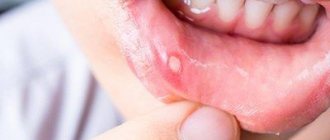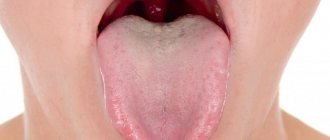Painful sensations in the larynx are one of the signs of diseases of the respiratory organs. Infectious diseases of the upper respiratory tract in children are diagnosed 3 times more often than in adults. As a result, pain in the throat area is a fairly common problem at an early age. In addition to a sore throat, respiratory diseases in childhood are most often accompanied by symptoms such as a runny or stuffy nose, red eyes, fever and weakness. Such manifestations are usually evidence of the development of a serious pathology. If pain in the larynx occurs, you should urgently consult a doctor to establish a diagnosis and prescribe the correct therapy.
Description of the disease
Follicular tonsillitis is a moderately severe variant of tonsillitis that can affect both infants and adolescents 15-18 years old.
Boys and girls are equally susceptible to pathology. According to statistics, this disease occurs in 8-15% of children. The disease is characterized by acute development, but with timely consultation with a doctor, it is accompanied by complete recovery in 90-92% of cases. The danger of the disease lies in possible complications:
- Acute rheumatic fever. When the cardiovascular system is damaged, the valve apparatus of the heart suffers. Acquired defects develop, which, if left untreated, change first the intracardiac and then the systemic hemodynamics of the patient.
- Formation of peritonsillar abscesses. In the area of the palatine tonsils, ulcers of different sizes form, which are a source of infection and can cause pathogenic bacteria to penetrate into the membranes of the brain (with the bloodstream).
- Infectious arthritis. Bacteria from the palatine tonsils penetrate into the joint cavity through the vascular bed. There they create foci of local inflammation, cause pain, and reduce the child’s range of free movements.
- Nephritis. Kidney damage is an uncommon complication (up to 6-7% of cases). It is characterized by the formation of a focus of chronic infection in the kidneys, which cannot always be completely eliminated.
When microorganisms penetrate the membranes of the child’s brain, meningitis develops.
The disease directly threatens the patient's life and requires hospitalization in the intensive care unit. Therefore, each episode of follicular tonsillitis should be under the supervision of a doctor. A child does not always need hospitalization. However, it is important for a specialist to assess the condition and determine further therapeutic tactics.
Symptoms of follicular tonsillitis in children
Follicular tonsillitis, like most other forms of tonsillitis, debuts with a sore throat (this picture is observed in 80% of cases). Discomfort occurs acutely - on the first day after exposure to the provoking factor. The intensity of pain varies from mild to severe. This depends on the individual characteristics of the child’s body, the aggressiveness of microorganisms and the activity of the immune system. Associated symptoms of follicular tonsillitis in children:
- Fever with an increase in body temperature to 38-39°C.
- Swallowing disorder. A sore throat can make it difficult for a child to eat or even drink. Infants often refuse to breastfeed and cry constantly.
- An increase in size of the palatine tonsils with the appearance of mucosal hyperemia.
- Foci of gray-white plaque form on the surface of the tonsils. When touched, they are easily removed with a cotton swab.
- Lymphadenitis is an increase in the size of nearby lymph nodes.
- General weakness, moodiness, disturbance of normal sleep.
Follicular tonsillitis is characterized by alternating episodes of severe weakness, which coincide with an increase in temperature, and the patient’s normal state of health. Hospitalization of children with this disease is carried out in case of a sharp deterioration in condition or persistent fever that cannot be treated with antipyretic drugs at home.
Actions before visiting a doctor
Before seeking medical help, it is recommended:
- Maintaining bed rest. This will make it easier for the body to withstand the increase in temperature and recover.
- Drinking plenty of fluids to speed up the elimination of pathogens from the body through sweat, saliva and urine. Moreover, you can drink not only water, but also warm tea (berry tea is best - raspberry, currant, lemon), compotes, herbal decoctions. When making lemon tea, do not put too much citrus in the drink. You should not give a child with a sore throat soda and sour drinks, as this is fraught with additional painful manifestations in the throat.
- Following a “gentle” diet. The child should eat often, and the portion should be small. During treatment, you need to avoid rough and spicy foods and minimize sweets.
- Gargling. In such a situation, it is better to use gentle herbal infusions, the raw materials for which are sold at any pharmacy. For rinsing, it is recommended to use products based on sage, chamomile, calendula, linden blossom, and eucalyptus. You can prepare the infusion yourself. To do this, you need to pour 3-4 teaspoons of the herb with hot water in a volume of 500 ml and leave to infuse for at least half an hour. It is necessary to gargle before or after eating food. The duration of the procedure is 2-3 minutes. After rinsing, eating and drinking is prohibited for half an hour.
Before starting drug treatment, you should definitely consult a doctor. It is also important to read the instructions for the medicine, which tell you how to dose the drug correctly, taking into account the patient’s weight or age.
Causes of follicular tonsillitis in children
The palatine tonsils are the first barrier to various microorganisms that enter the patient’s respiratory tract.
They are accumulations of lymphoid tissue rich in immune cells that protect a person from bacteria and viruses. Follicular tonsillitis is the result of a “breakdown” in the function of the palatine tonsils. This can occur either against the background of massive infection with microorganisms, or with an existing immunodeficiency. In both cases, bacteria and viruses (most often group A streptococci) penetrate the lymphoid tissue and begin to multiply. The tonsils turn from a protective organ into a source of infection, which can penetrate various organs through the bloodstream.
The disease is based on a local inflammatory process. Against the background of vasodilation, the tonsils become red and increase in size. Gray-white films are the result of the vital activity of microorganisms. An increase in their number is an unfavorable sign indicating the progression of the disease.
Factors that create conditions for easier penetration of bacteria and viruses into the palatine tonsils are:
- Hereditary predisposition.
- Hypothermia – local and systemic.
- Congenital or acquired immunodeficiency.
- Exacerbation of chronic diseases of other internal organs (cholecystitis, pancreatitis, pyelonephritis).
- Metabolic disorders (diabetes, obesity).
- Chronic processes in the paranasal sinuses of a child (sinusitis, sinusitis, ethmoiditis), otitis media, multiple carious teeth.
Follicular tonsillitis in children is rarely primary. The disease often occurs against the background of an already suffered catarrhal form of the disease.
Prevention of acute respiratory infections and acute respiratory viral infections in children
Prevention of acute respiratory infections should include, first of all, protection in children from sources of infection with acute respiratory diseases
, during periods of epidemic, it is recommended to wear a medical mask in kindergarten and school. In addition, you must:
- provide the child with vaccinations on schedule and during the epidemic;
- avoid hypothermia;
- carry out hardening;
- feed the child correctly - in a balanced manner, according to a schedule, with food rich in vitamins;
- spend less time in public places during outbreaks;
- at the first signs of illness, consult a doctor, even if you need to miss school or kindergarten;
- walk more with your child in the fresh air;
- introduce general strengthening gymnastics into the child’s daily routine.
Sources:
- S.O. Klyuchnikov, O.V. Zaitseva, I.M. Osmanov, A.I. Krapivkin, E.S. Keshishyan, O.V. Blinova, O.V. Bystrova. Acute respiratory diseases in children (Manual for doctors) // Russian Bulletin of Perinatology and Pediatrics, 2008, supplement No. 3.2008.
- L.A. Balykova, Doctor of Medical Sciences, corresponding member. RAS, T.I. Razdolkina, candidate of medical sciences, associate professor. Acute respiratory diseases in children // Remedium Privolzhye, 2021, No. 3(163), pp. 18-22.
- T.A. Samsygina. Modern treatment of acute respiratory diseases in children // Pediatrics, 2013, No. 3, pp. 38-42.
- Seto WH, Conly JM, Pessoa-Silva CL et al. Infection prevention and control measures for acute respiratory infections in healthcare settings: an update // East Mediterr Health J., 2013, i9 (Suppl. i), p. 39-47.
Markova Daria Olegovna Clinic
Author of the article
Markova Daria Olegovna
Specialty: endocrinologist
Experience: 14 years
The information in this article is provided for reference purposes and does not replace advice from a qualified professional. Don't self-medicate! At the first signs of illness, you should consult a doctor.
Diagnosis of follicular tonsillitis in children
Making a diagnosis of “follicular tonsillitis” is not difficult for an ENT doctor.
At the initial consultation, the doctor assesses the general condition, collects an anamnesis of the disease, and analyzes the complaints of the patient and his parents. After this, pharyngoscopy is mandatory. Using a light source and a special mirror, the ENT examines the oropharynx and palatine tonsils. When they increase and the presence of typical gray-white plaques, a diagnosis of follicular tonsillitis is established.
To assess the severity of the disease and identify possible concomitant diseases, a comprehensive examination is carried out:
- General and biochemical blood test. Based on the results of these tests, the doctor determines the severity of the inflammatory process and monitors liver and kidney function.
- Sowing a smear from the palatine tonsils onto a nutrient medium. This method allows you to accurately identify the causative agent of sore throat and select the optimal antibacterial drug.
Polymerase chain reaction (PCR) can also be used to identify the pathogen.
The technique is based on the ability to detect RNA or DNA particles of pathogenic microorganisms. If abnormalities in the functioning of other organs and systems are detected, the child is examined by related specialists (pediatrician, ophthalmologist, gastroenterologist).
Bacterial sore throat
Bacterial tonsillitis (BT) is a serious condition in which severe intoxication, weakness, headache, sore throat are felt, and catarrhal symptoms (cough, runny nose) are minimally expressed or completely absent. With BT, you can see a whitish coating on the tonsils. Without fail, the specialist observing your child must clarify the diagnosis, that is, exclude infections with similar symptoms. With bacterial sore throat, small white pustules the size of a grain form. In other infections, purulent discharge forms a uniform “film” over the affected areas of the throat. Enlarged lymph nodes in the neck under the jaws are a common symptom of the disease.
Causes of asthma
In addition to streptococci, which are the main pathogens, the disease can be caused by other bacteria, for example, pneumococcus, one of the most common causes of bacterial infectious diseases in children. The disease can also be provoked by staphylococci, bacilli - Pseudomonas aeruginosa and intestinal and opportunistic microflora of chlamydia, ureaplasma, mycoplasma.
Diagnosis of bacterial sore throat
First of all, the specialist must determine whether there have been cases of sore throat before, and if so, how often, and whether it is chronic. When assessing the patient's condition, the doctor must look at the throat to make sure that the mucous membrane and tonsils are affected by bacteria. Additional laboratory tests: general blood and urine tests are performed if necessary. A throat swab is also taken to rule out diphtheria. Complex diagnostics helps to distinguish a sore throat from diseases with similar manifestations: measles, scarlet fever, etc.
At home, to confirm the type (bacterial or viral), as well as identify the pathogen, the doctor may suggest diagnostics using a strip, which is needed to calculate the streptococcal bacterium; it can cause complications on the heart and kidneys, and also cause a chronic course of the disease. Streptococcus also causes scarlet fever; before the advent of antibiotic therapy, the disease was often fatal. The bacterial nature of the disease can be confirmed by a general blood test.
Treatment of bacterial sore throat
- Teach your child how to gargle correctly so that the solution also washes the back wall. A saline or antiseptic solution is suitable for regular rinsing.
- Lozenges, sprays, and lozenges have an antimicrobial and local anesthetic effect. If the child is old enough, explain that they should not be swallowed or chewed.
- Antipyretics are used if necessary if the temperature is 38.5C or higher.
- Antibiotics to which “your” pathogen is sensitive are prescribed only after receiving the results of a blood test and smears. Antibacterial drugs may have varying degrees of sensitivity to a specific group of pathogenic microorganisms. For asthma, antibiotics of the penicillin group, macrolides or cephalosporins can be prescribed.
Sore throat is a disease that can be overcome by bed rest, plenty of warm drinks, and soft, non-irritating dietary foods. Since the disease is contagious, it is better to use separate personal hygiene products, wash dishes separately, and temporarily stop close contact with others.
Treatment for viral and bacterial sore throats differs. We will return to the specifics of treatment for viral sore throat a little later.
Treatment of catarrhal tonsillitis in children
Follicular tonsillitis is one of the forms of tonsillitis that responds well to conservative treatment. With the help of medications, in 90-95% of cases it is possible to achieve the desired result. The main thing is to start taking the right medications on time.
Conservative treatment
The main goal of drug treatment of follicular tonsillitis in children is to “cleanse” the palatine tonsils from pathogenic microorganisms and strengthen the body’s immune defense. For this purpose, the following groups of drugs are used in otolaryngology:
- Antibiotics. Mandatory group of drugs. Broad-spectrum agents are traditionally prescribed early in treatment (before culture results are available). This allows you to effectively destroy bacteria without even identifying the exact pathogen.
- Rinse and irrigate the oropharynx with local antiseptics. Most often this is an aqueous solution of iodine, various sprays with anesthetics that help reduce the severity of pain in a child and improve swallowing.
- Non-steroidal anti-inflammatory drugs (NSAIDs). Prescribed to suppress an excessive inflammatory response and reduce the child’s body temperature.
It is recommended to use vitamin complexes to strengthen the defenses.
Surgery
Surgical interventions for follicular tonsillitis may be indicated when abscesses form in the area of the palatine tonsils. Peritonsillar abscesses are dangerous due to rupture with the penetration of pus into the vessels supplying the brain. Therefore, they are opened, the contents are removed and the wound is drained.
Diagnostic measures for pain in the larynx
A doctor can accurately diagnose the disease and identify what exactly triggered the appearance of such symptoms. The most important thing is to accurately determine the circumstances that led to the occurrence of painful manifestations in the throat, as well as to identify accompanying signs that usually indicate the source of the problem. For this purpose, certain laboratory tests (clinical tests of urine and blood) are prescribed. If there is a suspicion of bacterial damage, taking a smear on the flora from the mucous membranes of the larynx is indicated. Such diagnostics are very important. It is required to accurately diagnose the disease and prescribe appropriate antibiotics.
It should be noted that there is no universal method for treating a sore throat, since pain is only a sign signaling infection or the development of a certain pathology.
Questions
- Which doctor treats follicular tonsillitis in children?
An otolaryngologist is involved in identifying and treating follicular tonsillitis in children. - Is it possible to treat a sore throat on your own?
Independent choice of drugs for follicular tonsillitis in children under 3-4 years of age is extremely undesirable. Due to early age, many medications cannot be used in adequate doses. This leads to incorrect treatment. You can overcome a sore throat at home. However, in all cases, an in-person consultation with an otolaryngologist is required. This will help avoid the development of serious complications. - Does traditional medicine help with follicular sore throat?
Traditional medicine can have a positive effect in the presence of sore throat. However, it must be borne in mind that in case of high body temperature and pronounced signs of intoxication, antibacterial drugs should be prescribed in 100% of cases. It turns out that with follicular tonsillitis you can do without traditional medicine, but you cannot do without antibiotics. Therefore, in most cases, otolaryngologists do not recommend the use of non-traditional approaches due to the risk of losing valuable time. - Are anesthetic sprays harmful to children?
Anesthetic components in antiseptic sprays are contained in minimal doses. They are external anesthetics approved for use in pediatric practice. Therefore, to relieve pain in follicular tonsillitis, such sprays can be used in complex treatment.
Sources
- Clinical recommendations (treatment protocol) for the provision of medical care to children with tonsillitis (acute streptococcal tonsillitis) FSBI NIIDI FMBA RUSSIA, State Budgetary Educational Institution of Higher Professional Education Krasnoyarsk State Medical University named after. prof. V.F. Voino-Yasenetsky, Ministry of Health of the Russian Federation, Municipal Budgetary Institution of the City Children's Clinical Hospital No. 1 (Krasnoyarsk).
- Modern possibilities of antibacterial therapy in children with chronic tonsillitis. / E.P. Karpova, M.P. Bozhatova. // Russian. Medical journal. – 2010. – T. 18, No. 1. – P. 8-10.
- Acute tonsillitis in childhood: diagnosis and treatment. /VC. Tatochenko, M.D. Bakradze, A.S. Darmanyan. // Pharmateka. - 2009. - No. 14. - P. 65-69.











